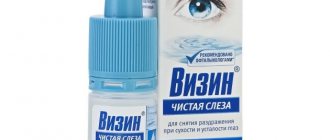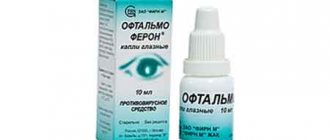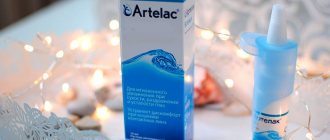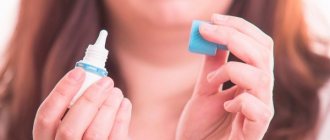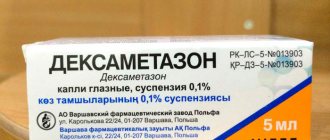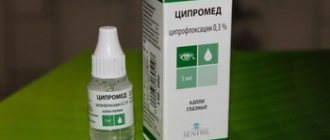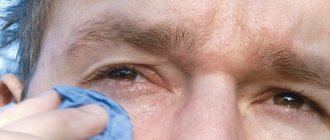Under dry eye syndrome This implies a violation of the production of moisture in the cornea of the eye, i.e. decrease in its hydration.
For a normal visual process, corneal moisture is an indispensable condition. As a result of a reduction in humidity, dry eye syndrome occurs, which not only causes discomfort, but also entails serious consequences.
Dry eye syndrome can be an independent disease of primary origin, but it can also be a complication of another disease.
General information
Dry eye syndrome or dry eye is an ophthalmological disease caused by a condition in which either the production of tears decreases or the evaporation of tear fluid increases due to a violation of the properties and quality of the tear fluid. The term “dry eye syndrome” refers to a complex of symptoms of drying ( xerosis ) of the surface of the conjunctiva and cornea due to the impaired stability of the tear film that covers the cornea.
According to MBK-10, the disease code is H-04.1. Tears are important for normal vision and maintaining healthy eyes. Dry eye is a widespread problem. Most often, this condition is observed in workers who are forced to spend a lot of time in an office environment, as well as in people over 40 years of age.
However, this condition has recently been increasingly observed in young people. This significantly worsens their quality of life, and sometimes reduces their productivity and even forces them to change their field of activity.
According to statistics, the disease is diagnosed in 9-18% of people, but in recent years the frequency of confirmation of this diagnosis has increased significantly.
Surgical methods of treatment
How to treat dry eye syndrome surgically? Treatment of the disease can be carried out using several minor operations to ensure the production and maintenance of a normal amount of tear fluid.
To maintain a sufficient amount of tear fluid on the surface of the cornea, occlusion of the tear ducts, which are responsible for draining fluid from the eyes, is used. When they overlap, fluid accumulates on the outer surface of the eye and provides sufficient hydration. The ducts are blocked with special plugs, which can later be removed. This is a simple procedure that can significantly improve the patient's condition.
The new generation of plugs are small thin rope-like objects that, when heated to body temperature, turn into a gel-like form and normally do not cause any sensation on the part of the patient. The advantage of such plugs is a single size for patients of all ages and sizes and the absence of irritating materials in the composition of the products.
Author:
Nikita Aleksandrovich Korobov, anesthesiologist
Pathogenesis
The development of this condition is based on the impaired stability of the tear film, which under normal conditions covers the anterior surface of the eyeball. In a healthy person, the normal thickness of the tear film is 10 microns, its structure is heterogeneous. Its outer side is covered with a thin film of lipids , which prevent too active evaporation of moisture and heat transfer from the conjunctiva and cornea. The second layer is watery, it is produced by the main and accessory lacrimal glands. It is the basis of the tear film. Thanks to its constant renewal, the protective, metabolic and other functions of the tear film are ensured.
The pathological condition occurs due to disruption of the natural processes of renewal of the tear film. Such disturbances may be associated with various factors - a failure in the production of tears, lipids and mucins, a violation of the rate of film evaporation, etc.
Healthy and damaged tear film
What it is?
Xerophthalmia is a disease in which the surface of the cornea and conjunctiva is not sufficiently moistened due to impaired secretion of tear fluid or a decrease in its quality. The pathology is accompanied by pain, pain in the eyes, burning and itching. Other unpleasant symptoms may also be present.
Diagnosis of dry eye syndrome is complex and is carried out by an ophthalmologist. Xerophthalmia is quite often recorded in medical practice. Its frequency is 12% of cases in young people. After 50 years of age, the risk of developing pathology increases sharply to 67%.
Classification
Dry eye syndrome, depending on its etiology, is divided into syndromic , symptomatic and artificial .
- The manifestation of syndromic type A disease is associated with a decrease in the secretory function of the lacrimal glands and goblet cells of the conjunctiva, which occurs as a result of the disease. This condition can be a consequence of endocrine diseases, collagenosis, menopausal syndrome , Stevens-Johnson syndrome and other diseases.
- Symptomatic - its development is associated with tissue dryness due to anatomical reasons, scarring of the mucous and lacrimal glands, the use of certain medications (adrenergic blockers, antidepressants, antiarrhythmic drugs, local anesthetics, etc.). This type of disease also includes a transient type of dry eye syndrome, which develops as a result of inflammation in the cornea and conjunctiva.
- Artificial - develops due to exposure to the external environment - smoke, monitor radiation, ultraviolet radiation, cosmetics. Also, this type of disease can develop due to wearing incorrectly selected lenses. In young people, this type of disease is often associated with the so-called office syndrome, when the tear film evaporates due to the constant use of air conditioners and a decrease in the frequency of blinking while working at monitors. A separate group includes changes that occur after surgical interventions associated with the presence of sutures, scars, etc.
Depending on the severity of the disease, three degrees are distinguished: mild , moderate and severe .
- Mild degree – a compensatory increase in tear production is possible, which increases under the influence of negative external factors.
- Moderate degree - there are clear signs of a lack of tear fluid production: the eyes turn red, there is mucous discharge in the conjunctival cavity, there are complaints of dry eyes.
- Severe degree - severe symptoms of xerosis with a pronounced decrease in tear production.
Main diseases associated with dry cornea
Cause-and-effect relationships in the case of eye diseases can be blurred. That is, in some cases, dry eye syndrome opens the way to infection and becomes the cause of a general decrease in immunity, while in other situations, dry eye itself appears as a consequence of a bacterial or fungal infection. Only an ophthalmologist can find out what became the primary problem, but in most cases the order of problems plays a lesser role than the general consequences of the disease.
Among the most unpleasant and common diseases, one way or another associated with dry eye syndrome, are blepharitis, keratitis, keratoconjunctivitis and conjunctivitis. Erosive lesions of the cornea are more likely to be the consequences of the disease, but the opposite phenomena occasionally occur.
Blepharitis
A disease of the eyelids associated with inflammation of the Moll gland located between the eyelashes. It manifests itself in the form of small reddish swellings on the upper and lower eyelids, the release of foamy secretions, loss or thinning of eyelashes, sticking together of eyelashes after sleep, and the formation of crusts on the eyelids. Blepharitis often appears in old age, and is accompanied by itching, burning, pain, and blurred vision. More than half of patients with blepharitis also have dry eye syndrome, since the ducts of the glands that produce tear fluid are damaged due to swelling.
The disease is treatable; depending on the form of the disease, long-term antibacterial, antifungal (for seborrheic blepharitis) or antiparasitic (for demodex blepharitis) therapy may be required.
Correction of dry eye syndrome caused by blepharitis is usually limited to the use of artificial tears, but in cases where the disease is advanced, it may be necessary to close the tear duct that drains excess fluid from the eyes.
Keratitis
Cloudiness of the cornea is called keratitis and is most often associated with dry eye syndrome or with actions that indirectly lead to its occurrence. The characteristic clouding and disappearance of the shine of the cornea, redness of the sclera, and change in the color of the iris looks quite creepy, and, what is especially unpleasant, can lead to irreversible loss of vision.
As a rule, the development of the disease begins under the contact lens. Insufficient hydration, microtrauma of the cornea, and foreign particles entering the eyes from the surface of poorly cleaned lenses lead to the development of infectious keratitis. The presence of a herpes virus or untreated candidiasis in the body can provoke acute keratitis and damage to other eye tissues, developing into keratoconjunctivitis or keratouveitis.
Ignoring keratitis, in addition to the painful process, can cause corneal blindness. To treat the disease, it is necessary to remove foreign bodies from the eye (if any), carry out a full course of antibacterial (antifungal, antiviral, antiparasitic) therapy, restore the normal level of corneal hydration and stop wearing contact lenses until complete recovery.
Ulcerative keratitis
In addition to filamentous keratitis, in which thin filaments are formed, attached at one end to the cornea and irritating it when blinking, ulcerative keratitis manifests itself in the form of erosions that destroy the superficial and deep layers of the cornea. As a rule, the development of ulcers occurs gradually, and, depending on the causes of the disease, can lead to complete blindness.
Superficial ulcers, in which part of the epithelium is destroyed, are treatable and heal completely due to the migration of neighboring cells through division. With such prolongation of erosion, new capillaries do not form, so this self-healing mechanism is useless for deeper damage.
Ulcers affecting the lower layers of the cornea are usually very painful and sensitive even to neutral moisturizing drops, so treatment and prevention of infections during the healing of deep erosions are accompanied by significant discomfort. Complete restoration of the damaged epithelium in this case occurs due to the introduction of capillaries from the conjunctiva, and requires much more time.
Because the human eye is designed to heal physical damage on its own, the ophthalmologist's job is to provide antiviral, antibacterial, and antifungal therapy during corneal repair. Not only the patient’s vision, but also the health of all tissues surrounding the eyes often depends on a correct and timely diagnosis.
Conjunctivitis
The inner surface of the eyelids and the visible surface of the sclera are covered with the thinnest transparent tissue - the conjunctiva. Viruses, bacteria, fungi and negative physical influences can cause inflammation and redness, which is called conjunctivitis.
Often the cause of conjunctivitis is drying of the cornea due to dry eye syndrome. A decrease in the antimicrobial protection provided by the tear fluid opens the way for infections, and insufficiently rapid cleansing of dust particles and pollen particles that get into the eyes provokes an allergic reaction. Treatment of conjunctivitis caused by dry eye syndrome begins with determining the cause of the inflammation. If the problem is allergens entering the conjunctiva, treatment is carried out with antihistamines and regular moisturizing of the eyes with artificial tears with anti-inflammatory additives. If the cause of the disease is infection on the tissue, a plan is developed for the use of general and local antibiotics in combination with moisturizing and healing drops.
Causes of dry eye syndrome
The causes of the disease are associated with the incorrect process of tear formation and its distribution over the surface of the eye. The reasons for this are related to the following phenomena:
- Insufficient number of tears - the process of their production is disrupted with age, with various diseases, after taking certain medications, due to certain environmental conditions.
- Poor tear quality - the tear fluid contains fat, water and mucin (a sticky substance). If any of the components is not enough, a person may complain of dry eyes.
So, dry eye syndrome can be caused by the following factors:
- Age – this condition may be due to the natural aging of the body. Very often, people over 65 years of age experience unpleasant symptoms associated with such manifestations.
- Treatment with medications – Taking a number of medications causes similar side effects. We are talking about treatment with antihistamines and decongestants, antidepressants, drugs to lower blood pressure, etc.
- Gender – in women this problem occurs more often, since they have more pronounced hormonal changes associated with pregnancy , menopause , and taking oral contraception.
- Diseases - a similar problem is typical for people suffering from diabetes, rheumatoid arthritis , and thyroid diseases. Dry eyes are common for those who have inflammation of the eye muscles, eyelids, or cornea.
- Wearing contact lenses - the use of lenses leads to disruption of the water-fat balance of the cornea. This condition occurs especially often if the lenses are incorrectly selected.
- Environmental influences - dry climate, smoke, strong wind lead to increased evaporation of moisture and cause dry eyes.
- Spending a long time in front of a monitor – if a person sits in front of a monitor for too long, he blinks less often and the surface of the eyes dries out faster.
- Ophthalmic surgery - laser vision correction and other interventions can lead to excessive dryness.
- Malnutrition and vitamin deficiency - keratomalacia leads to this pathology. This is a condition caused by a lack of vitamin A in people who do not eat enough protein. Keratomalacia is a degeneration of the cornea that also affects the lacrimal glands and conjunctiva.
Scientists note that a hereditary factor associated with a genetic deficiency in the production of tear secretion also plays a certain role in the development of pathology.
This condition develops quite often in people with chronic conjunctivitis and Sjögren's disease .
Types of drops for dry eyes
When dryness and discomfort occur in the eyes, it is not recommended to use the first moisturizer that is offered at the pharmacy. Sometimes it is necessary not only to moisturize the outer mucous membrane, but also to remove the cause that caused the pathology. It is necessary to consult an ophthalmologist so that he can examine the affected area and prescribe an effective treatment option. Types of drops:
- Antibacterial drugs . They are used if the cause of dry mucous membranes is an infection. Such medications block the action of harmful microbes, remove discomfort and redness.
- Vasoconstrictors . If the eyes are constantly under tension, the blood vessels dilate and become injured, drops help eliminate burning and redness. Thanks to this remedy, the vascular system of the visual organs is strengthened.
- Vitamin drops for dry eye syndrome provide additional nutrition. They compensate for the lack of useful components and are widely used to prevent eye pathologies.
- The therapeutic category of drugs gives a chance to get rid of specific diseases diagnosed by an ophthalmologist. Such remedies fight the source of the disease and its symptoms.
- Moisturizing eye drops help eliminate dryness and discomfort in the visual organs for a long period of time.
- Antihistamine drops for dry eyes are prescribed in case of excessive tearing and redness of the mucous membrane caused by food or seasonal allergies.
- How to pick up a car from an impound lot
- How to knit booties with knitting needles
- Fitness classes at home for weight loss
Moisturizing
This type of remedy for dry eyes is considered the safest, so they are prescribed to adults and children. A moisturizing solution is a liquid that has a composition very similar to human tears. It is necessary for those who constantly wear contact lenses or often work at the computer. The most popular drugs in this group:
- Lecrolin . These are drops in the eyes for dryness and pain. The product has an antihistamine effect, normalizing the functions of the visual organs and eliminating the inflammatory process. The drug has virtually no side effects, so it can be used for a long time. The main substance of the drops is sodium cromoglycate. Contraindications: allergy to the constituent components of Lecrolin. Drops for dryness cost from 85 to 90 rubles per bottle.
- Cromohexal based on sodium cromoglycate has an antiallergic and protective effect. It is a keratoprotector - a remedy that restores the tear film, which is destroyed due to frequent overstrain of the visual organs. The drug should not be given to children under two years of age if they are hypersensitive to the elements of the drug. During pregnancy and lactation it is used with caution. Side effects: burning, blurred vision, dryness, swelling of the conjunctiva, barley. The average price of Cromohexal is 100 rubles per package.
- Systane Ultra effectively fights irritation and helps regenerate the tear film. The drug can be used without removing contact lenses. It includes polyethylene glycol, sodium hydroxide, boric acid and other components. Contraindications: age under 5 years, allergy to the components of the drops. Sometimes side effects occur - irritation, lacrimation. The approximate cost of the drug is 450-600 rubles.
- Natural tear . This product has an almost identical composition to human tear secretion. Drops are used to restore its deficiency in the presence of symptoms of dry eye syndrome. Active ingredients: hypromellose, dextran. Natural tears are contraindicated in children under 18 years of age and those with individual intolerance to the drug. As a rule, the medicine does not cause side effects, but sometimes an allergic reaction may occur to it. The price of the product in Moscow and the region is 240-320 rubles.
- Oksial . This solution with a moisturizing effect, made on the basis of hyaluronic acid, softens dry conjunctiva and cornea. The process of restoration of the functions of the visual organs is significantly accelerated. Dry eye drops may cause irritation, but in very rare cases. The cost of Oksial is 350-450 rubles.
- “Cornflower blue” drops or Innoxa are classified as hypoallergenic products. The medicine includes natural ingredients: extracts of cornflower, chamomile, elderberry, and sweet clover. Eye drops relieve fatigue, eliminate dryness and irritation, and have an anti-inflammatory effect. The drug should be prescribed with caution to children under 14 years of age. Innoxa is contraindicated if you are allergic to plant elements from the composition. Adverse reactions almost never occur. You can purchase the medicine for 500-550 rubles.
- Cationorm is a unique cationic emulsion for moisturizing the eyes, which restores all three layers of the tear film, permanently eliminating severe, intense discomfort and dry eyes that appear throughout the day, even in the morning, and prevents the further development of dry eye syndrome. Cationorm does not contain preservatives and can be used in conjunction with contact lenses. Cationorm is suitable for people with severe complaints of dryness and eye discomfort, which manifest themselves even in the morning; people who wear contact lenses for a long time (more than 6 months, more than 5 days a week and/or more than 10 hours a day); people with other eye diseases (glaucoma, blepharitis, allergic conjunctivitis); people using hormone replacement therapy (menopausal hormones, oral contraceptives).
- Ocutiarz - eye drops with ultra-high molecular weight hyaluronic acid without preservatives to quickly eliminate discomfort and eye fatigue that appears at the end of the day after intense visual work. Ocutiarz is stored for 6 months after opening the bottle, it can be instilled onto contact lenses, and it is also often used to eliminate discomfort after ophthalmological operations on the cornea. Okutiarz is suitable for people with complaints of dry eyes occasionally, in the evening, after intense visual work (computer/office syndrome in office employees, motorists/motorcyclists, frequent fliers, travelers, students); people who have recently worn contact lenses are just learning to use them (to make it easier to remove and put on lenses); people within 6 months after eye surgery (LASIK, PRK, cataract extraction).
- Oftagel is an eye gel with carbomer in maximum concentration, which moisturizes for a long time, eliminates lacrimation and does not require frequent instillation; in addition, it can be used once at night, if it is not possible to instill moisturizing drops during the day. Oftagel is suitable for people with complaints of periodic dry eyes and/or lacrimation and an unwillingness/inability to instill drops more than once a day.
Systane Ultra, Alcon
Relieving fatigue
This group of medications has a stimulating effect. They include vitamins and relieve tension well, help eliminate dry eye syndrome, and preserve clarity of vision. The most effective means:
- Emoxipin . These eye drops for dryness and fatigue are a synthetic antioxidant. The active ingredient is methylethylpyridinol. The drug strengthens the eye vessels, promotes the resorption of minor hemorrhages, protects the retina and cornea from the negative effects of the sun. Adverse reactions: mild burning and tingling, redness or swelling of the conjunctiva, mild pain. The drug should not be used during pregnancy or high sensitivity to the composition. The average price is 200-300 rubles.
- Taufon . The drug is often prescribed for the treatment of cataracts and the removal of various types of dystrophic processes. Drops have a regenerating and energy-generating effect, improve metabolic processes in the visual organs. 1 ml of the drug contains 40 mg of the active substance - taurine. The medicine is prohibited for use if you are allergic to its constituent elements, pregnant, lactation, or under 18 years of age. Redness, burning, and cloudiness in the eyes may appear. The approximate cost of Taufon is 40-50 rubles.
- Oftan katachrome . The drug is used to block the development of cataracts, relieve swelling, and moisturize the mucous membrane. The composition of the medicine includes: nicotinamide, adenosine and cytochrome. It is not recommended to use it in case of individual intolerance; children under 18 years of age cannot be treated with it. After use, a short, mild tingling sensation may occur. Side effects: itching and rash on the skin of the face, redness, contact dermatitis (in rare cases - nausea, decreased blood pressure, weakness, fever). Oftan price is from 150 to 200 rubles.
- Quinax dry eye drops are also effective for treating cataracts. They help actively dissolve protein compounds that are deposited on the lens of the visual organ. Main active ingredient: sodium polysulfonate azapentacene. With regular use, the drug protects the eyes well from the effects of free radicals formed. Contraindication: allergy to the components of the product. No side effects were recorded. The average cost of Quinax is 350-550 rubles per package.
Vasoconstrictors
Such drugs are prescribed to eliminate pain and discomfort, which are symptoms of severe dry eye syndrome. The solutions have an antiseptic, anesthetic and vasoconstrictor effect, and well moisturize the outer mucous membrane. Examples of effective medications:
- Vitabact . This drug for the treatment of diseases of the anterior edge of the eyeball (keratitis, conjunctivitis) has an antiseptic, antimicrobial effect, destroys pathogenic microorganisms, some viruses and fungi. The active ingredient in Vitabact is picloxidine dihydrochloride. The drug should not be used when carrying a child, breastfeeding, or hypersensitivity to the constituent elements of the drug. After use, a burning sensation and hyperemia (swelling, redness) of the mucous membrane may appear. The price varies from 300 to 330 rubles.
- Okomistin solution is very effective for the treatment of diseases of the visual organs, which are caused by fungi, chlamydia, viruses, gram-negative and gram-positive bacteria. The product is made on the basis of the medicinal compounds ammonium chloride monohydrate and benzyldimetrile. Contraindications: patient age under 18 years, pregnancy and lactation, allergy to constituent components. Sometimes after use there is a burning sensation and slight discomfort that goes away within 20-30 minutes. The cost of Okomistin is 80-100 rubles.
- Octilia . This vasoconstrictor is an alpha-adrenergic agonist and relieves itching, redness, and burning. The therapeutic effect is felt within 10-15 minutes after instillation of the solution. Octilia is not absorbed into the blood and causes virtually no side effects, but with prolonged use of the medicine, addiction can occur. It should not be used during lactation and pregnancy, intolerance to the composition, under the age of 3 years, and with glaucoma. You can buy the medicine for 250-300 rubles.
- The drug Visoptic with a vasoconstrictor and anti-edematous effect has many positive reviews, removes irritation, and restores the tear membrane. The main active ingredient is tetrizoline hydrochloride. The medication is contraindicated for glaucoma, under the age of 3 years, for corneal dystrophy, bacterial conjunctivitis, acute heart failure and hypersensitivity to the composition. Adverse reactions: burning, redness, increased intraocular pressure, dry nasal mucosa, dilated pupils. Price - 140-200 rubles.
Symptoms of dry eye syndrome
If a person develops dry eye syndrome, he or she will complain of the following symptoms:
- feeling of constant irritation, itching and burning in the eyes;
- feeling of constant tension;
- increased tearfulness, profuse lacrimation after severe irritation;
- a buildup of sticky mucus in or around the eye;
- feeling of a foreign object in the eye;
- high sensitivity and hyperemia ;
- photophobia , inability to concentrate vision at dusk;
- discomfort when wearing lenses;
- blurred vision, pain in the eye.
Typically, dry eye causes some of these symptoms to occur sporadically. Their intensity may vary, and the influence of some of the factors described above may aggravate the condition and increase the intensity of such symptoms.
Symptoms are often less severe on foggy or rainy days when the humidity is high.
The conjunctiva in such patients is hyperemic, they blink very often.
Symptoms of dry eye syndrome
conclusions
Since dry eye syndrome can develop at any age, prevention measures must be taken from childhood. Thus, it is very important to teach your child to wash his hands after walking and going to the toilet, and to explain that there is no need to rub his eyes. It is also useful to explain that in strong winds it is necessary to protect your eyes with your palms or special glasses, and when visiting pools and ponds, follow the rules of swimming. In extreme heat, it is better to use special bandanas to prevent acrid sweat from flooding your eyes.
Because some types of infections can be transmitted through personal hygiene items, you should avoid sharing towels, soap, and washing supplies. Some diseases, such as demodicosis, can be transmitted through close contact, so you should avoid hugging people you don’t know well or who are clearly unhealthy, which is common in some societies.
The slightest problems with vision, for example, itching or sticking of eyelashes in the morning, is a serious reason to visit an ophthalmologist. The expression “it will go away on its own” in relation to eye diseases is unacceptable, because even if vision does not deteriorate in the end, the infection can penetrate the brain and lead to serious neurological or mental disorders, and even death.
It is undesirable to choose moisturizers, and especially eye medications, based on price, advertising slogans, or the opinion of a pharmacy worker. As a rule, 10 outwardly indistinguishable drops have, respectively, 10 important functions that correct various vision problems. For example, some drops have a relaxing effect and are used for constant eye strain, others form a denser and more stable moisturizing film, protecting the eye in extreme cold and wind. There are special eye products with an antibacterial effect, used in hot countries, drops with vitamin A to compensate for vitamin deficiency, and so on. Choosing without understanding the differences is pointless and, most importantly, ineffective.
Self-diagnosing dry eye syndrome is also not recommended. It is likely that the cause of itching and burning lies in damage to the cornea or the inner surface of the eyelids, and the eyes seem to be “sprinkled with sand” from constant lack of sleep and allergies to birch trees blooming outside the window. Or, conversely, filamentous keratitis develops on the cornea, caused by sand getting into the eyes, but the initial stage feels similar to dry eye syndrome, and adequate treatment is delayed.
Competent prevention and timely contact with an ophthalmologist will help you avoid unpleasant and risky mistakes, as, indeed, in any health situation.
Tests and diagnostics
In order to establish a diagnosis and conduct a comprehensive examination, traditional clinical techniques are used, and in doubtful cases, special functional tests are carried out.
Conducting a clinical examination includes collecting anamnesis, determining what complaints the patient has, examination using all the necessary tools to confirm the diagnosis and establish the causes of such manifestations.
During the examination, the doctor determines objective microsigns of xerosis .
A biomicroscopic examination of the conjunctiva and cornea is carried out, during which a variety of diagnostic dyes are used, which facilitates diagnosis.
The development of dry eye syndrome may be indicated by the presence of degenerative changes on the conjunctiva and cornea and within the open palpebral fissure.
If during the above examinations the doctor is unable to detect the nature of the changes, a functional examination is performed. To do this, two special tests are used sequentially ( the Norn method and the Schirmer method ), which make it possible to assess how stable the precorneal tear film is and to measure how tears are produced.
A special study of the osmolarity of tear fluid is also carried out.
Those patients who constantly use contact lenses should regularly visit an ophthalmologist in order to identify and correct problems in a timely manner.
The dangers of self-medication
It has already been noted that the lack of timely treatment and self-administration of eye drops can, and almost always worsen, the condition, but it is worth considering this issue in more detail. Self-medication is not indicated even for ophthalmologists, since independently examining your own eyes is extremely problematic. Moreover, a non-specialist will not be able to determine the cause of dry eye and, at best, will only be able to temporarily mask the symptoms of the disease.
You can choose moisturizing eye drops for every day on your own, especially if a problem such as dry eye syndrome has not arisen before. When choosing contact lenses, you should listen to the opinion of an ophthalmologist, who will help you navigate the materials and compatibility of lenses, solutions and drops.
When it comes to therapeutic and prophylactic drops, it is no longer possible to do without a doctor’s recommendation. The reason is simple - depending on the stage of dry eye, drops with different additional components are selected: antimicrobial, decongestant, soothing, analgesic. It is often necessary to instill several types of drops in a certain order, with a break of 4-6 hours.
It is impossible to independently develop such a treatment regimen, so the patient, as a rule, is limited to tetracycline ointment and any soothing drops. As a result, inflammation gradually destroys the cornea and affects the more sensitive tissues of the eye. If the process occurs under a contact lens, intense pain may occur, and the lens itself may become cloudy and quickly get dirty.
At the stage when the pain cannot be drowned out, even adherents of traditional medicine turn to an ophthalmologist. Unfortunately, in such a situation, the doctor is forced to act quickly in order, if possible, to stop the spread of infection to the brain, and only then to save the eye. As a result of emergency assistance after prolonged self-medication, vision may be partially or completely lost.
Treatment with folk remedies
Folk remedies can be used as auxiliary methods and a way to cope with mild forms of dry eyes. The following traditional methods of treatment are practiced:
- Compresses with tea. It is necessary to pour 1 tsp. green tea 1 tbsp. boiling water and wait 5 minutes, covering the container with a lid. Strain the tea and cool it. Soak two cotton pads in it and place on closed eyes. Lie down with the compress for 3 minutes. Repeat the procedure several times.
- Compresses with infusion of calendula and chamomile. The infusion is prepared in the same way as green tea, taking 1 tsp. dry raw materials of each plant. Compresses are carried out in the same way.
- Glycerol. This remedy helps get rid of dry mucous membranes. It is necessary to carefully drop a few drops onto the cornea and blink a little so that the product is evenly distributed. This procedure should be carried out once every two days.
- Aloe vera drops. It is necessary to take equal parts of fresh aloe juice and chamomile infusion, mix thoroughly and drop into the eyes in the morning and evening.
- Rinse with chamomile decoction. To prepare a solution for washing, use 2 tbsp. l. dry raw materials pour 1 tbsp. boiling water When the product has infused, strain and rinse your eyes morning and evening. You can also use sage herb and oak bark for rinsing.
- Parsley compresses. Fresh parsley leaves need to be chopped, placed on the eyelids and left for 15 minutes. Compresses can be applied every day, as parsley juice is good for the eyes.
- Rinse with linden decoction. Prepare an infusion similar to chamomile infusion. It can be used both as an eye wash and as a cold compress. To do this, prepare ice cubes from the broth and apply them to the eyes, wrapped in napkins.
- Mint compresses. Fresh or dry mint leaves need to be chopped and 1 tbsp. l. Pour a glass of boiling water over this raw material. After about an hour, you need to take out the leaves and apply them to your eyes, holding the compress for about 20 minutes.
- Potato juice compress. You need to grate the potatoes, squeeze out the juice and soak gauze or cotton pads in it. Place the compress on your eyes for 20 minutes. After the compress, it is important to give your eyes peace for several hours.
- Cucumber juice compress. In the summer, you can similarly apply compresses from cucumber juice.
How not to worsen the condition of the cornea?
Along with useful and relatively safe folk methods of protecting the eyes from dryness and disease, there are harmful and dangerous recipes. For example, washing the eyes with old brew, especially from tea bags, is considered by many to be a panacea for keratitis, but in reality the opposite happens. Rubbing purulent and swollen eyes with tea leaves irritates the damaged cornea, and using tea bags with unknown contents as a compress often leads to bacterial and fungal infections on the initially weakened mucous membranes of the eye.
Diluted lemon juice, which some “healers” recommend for redness and burning of the eyes, causes irritation, and in the presence of microerosions, it can corrode the corneal tissue, causing serious burns. The water used for the solution may contain a lot of different salts, suspensions, compounds and microorganisms, which, if they get on the irritated conjunctiva, can cause a whole bunch of complications.
In addition to advice and recipes that it is better not to use, understanding the possible consequences, there are a number of instinctive actions that should be controlled. And first of all, we are talking about the desire to scratch the eyes when feeling dry. In general, rubbing the eyes provides quick hydration and micro-massage of the eyes, and when moving the hand to the nose, it removes trapped dust particles. It would seem that nature itself provides eye protection. However, the negative consequences in the form of damage and micro-tears of the cornea or fragile capillaries, infection and drying of the released tear fluid significantly exceed the possible benefits. This is why ophthalmologists prohibit touching your eyes with unwashed hands and recommend developing an alternative habit: moisturizing your eyes with drops every time you feel the urge to rub your eyelids.
Prevention
To prevent the development of this disease, you must follow these rules:
- Train yourself to blink regularly while working at the computer or reading. It is also important to take breaks as often as possible.
- Carefully observe eye hygiene, wash with warm water, and try to increase the humidity level in the room.
- Wear quality sunglasses to protect your eyes from the sun and wind.
- Avoid exposure to factors that provoke this syndrome. This is excessive heat in the room, the use of a hairdryer, cigarette smoke, etc.
- Drink enough liquid – up to 2 liters per day.
- Stop smoking.
- Don't spend too much time on gadget screens.
In children
This disease is often diagnosed in children and adolescents, and its causes are the same as in adult patients. If a child complains of discomfort in the eyes, you should immediately visit a pediatric ophthalmologist. It is also important to take into account the fact that in a child, dry eye syndrome may be a sign of some serious diseases: blepharitis , chronic conjunctivitis , kidney disease, a number of infectious diseases, Sjogren's syndrome , malignant lymphoma , etc. Therefore, it is very important to consult a doctor as early as possible.
Diet for dry eye syndrome
Diet for eyes, nutrition to improve vision
- Efficacy: therapeutic effect after 2 months
- Timing: constantly
- Cost of products: 1800-1900 rubles. in Week
Proper nutrition can significantly improve a person's dry eye condition. It is very important to include in the menu those foods that contain the vitamins and minerals necessary to improve your condition.
The menu should include products containing the following vitamins and minerals:
- Vitamin A – Since this vitamin is part of the tear film, it is very important. To prevent a deficiency of this vitamin, the menu should include fatty fish, liver, peaches, and melon.
- Vitamin D - reduces inflammation, reduces sensitivity to light. You need to eat tuna, salmon, eggs, herring.
- Vitamin E is a powerful antioxidant that is very beneficial for the eyes. Contained in vegetable oils, legumes, liver.
- Omega-3 fatty acids reduce the severity of unpleasant symptoms in people with this problem. The largest amount of them is contained in fish of fatty varieties.
Thus, the basis of nutrition for this disease should be plant foods, dairy foods, and fish dishes. There should be as little animal fat and meat in the diet as possible.
It is also important to avoid alcohol, as alcohol greatly dries out the cornea, increasing its sensitivity.
Consequences and complications
If measures are not taken to treat this disease for a long time, serious complications can arise, which can subsequently lead to deterioration of vision and even loss of vision.
If the cornea constantly dries out, recurrent erosions and ulcers may appear on it, and later scars may form. This will negatively affect your vision.
With insufficient production of tear fluid, the process of self-cleaning of the eyes worsens. As a result, a favorable environment is created for the proliferation of pathogenic microorganisms, which leads to the manifestation of inflammatory processes - keratoconjunctivitis , keratitis , etc.
List of sources
- Brzhesky V.V., Somov E.E. “Dry eye” syndrome: a disease of civilization // Consilium-medicum (application “Ophthalmology”). - 2001. - Volume 3. - No. 12. - P. 12-18.
- Maychuk Yu. F., Yani E. V. Choice of drug therapy for various clinical forms of dry eye disease. Ophthalmology. - 2012. - T. 9. - No. 4. - P. 58-64.
- Moshetova L.K., Koretskaya Yu.M., Chernakova G.M., Borisova NA Dry eye syndrome (clinic, diagnosis, treatment). // Guidelines. M.: RMAPO. - 2002. - 24 p.
- Polunin G.S., Polunina E.G. “Dry eye” // Supplement to the magazine “Health”, “For those who treat.” - 2007. - No. 3. P. 4-33.
